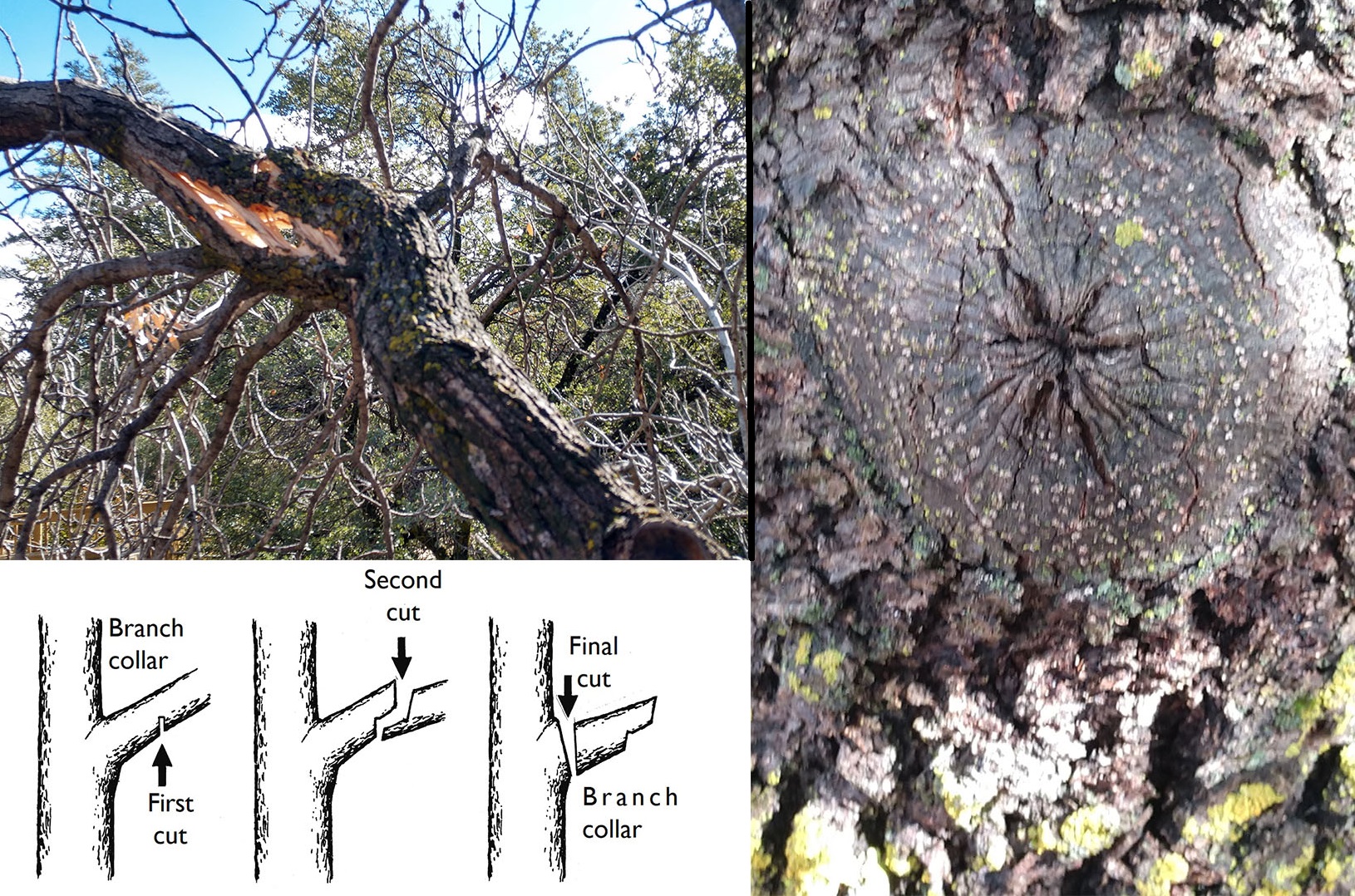 Pruning Trees After Storm Damage - December 11, 2019 Jeff Schalau, Agent, Agriculture & Natural Resources University of Arizona Cooperative Extension, Yavapai County Many residents are cleaning up following the recent heavy, wet snow and high winds. Many trees were damaged and others blew over completely. As you initially assess storm damage, you should carefully consider the following factors. Are power lines, underground utilities, structures, or other hazards involved? Does the damage warrant tree removal? Can you prune the tree yourself? Does the damage warrant professional assistance? Branches two inches in diameter or less and low to the ground may be pruned with handsaws. Heavy pruning work is dangerous and property owners should consider hiring a certified arborist to properly prune and dispose of the materials. Pruning branches causes a wound in the tree which could adversely impact the tree’s health if done improperly. Pruning removes the tree’s foliage which reduces the tree’s ability to create food during photosynthesis. Pruning cuts also create potential entry points for disease organisms. Safety is also a primary concern. Broken branches can become tangled in the tree’s canopy and later fall to the ground. Large broken branches suspended in the canopy are called “widow makers” and should be removed by professionals where they are a risk to people, pets, or structures. Trees differ in their ability to recover and regrow following damage and pruning. Most coniferous trees (evergreens including pine, spruce, fir, juniper, cypress, cedar, etc.) have a single dominant leader and do not have adventitious buds that generate new growth. They are also better able to withstand wind and snow loads. The only pruning that I recommend for these conifers is to remove dead branches and prune broken branches back to the next lowest branch or trunk. Deciduous trees (those that lose their leaves) vary in their natural growth forms and often have multiple leaders. Deciduous trees are pruned differently than conifers and often different species of deciduous trees require different pruning approaches. Storm damage is more common in deciduous trees and sometimes removal is the best solution. Cottonwoods and Siberian elms are especially susceptible to storm breakage. Small branches (two inches and less) can be removed with a hand saw by using the “three cut” procedure. Proper placement of the final pruning cut is critical. The first cut should be made eight to ten inches above the location of the final cut and start from the underside of the branch. This first cut should only go halfway through the branch. The second cut should be on the top of the branch an inch or so above the first cut. The second cut will sever the branch above the final cut and removes the weight of the branch and prevents bark stripping. The final cut should be just above the branch collar (a slight swollen area at the base of the branch). The branch collar contains tissue that will regrow to cover the pruning wound. Pruning paint or sealer is not recommended and research has shown these compound inhibit wound recovery. Proper pruning cuts on healthy trees will callous over and heal without pruning compounds. Internally, trees also have mechanisms that compartmentalize damage from rot organisms (usually fungi) to minimize internal damage to the tree. The branch collar’s appearance varies and may be less visible on some tree species than others. Cutting away the branch collar removes the ability of the tree to heal itself and makes a larger than necessary wound. Conversely, leaving a branch stub that is too long will not allow healing and create a potential entry point for disease. Homeowners should become educated about “topping trees”. Never cut the main branches of a tree back to stubs. Ugly, weakly attached limbs often will grow higher than the original branches and are more likely to break off in a future storm. Become educated about hiring a tree care professional and be wary of tree workers that go door-to-door soliciting tree pruning jobs. Many homeowners have chainsaws and the operators should be aware of proper safety procedures. Chainsaws are dangerous and are best used for pruning by professionals. If you are using a chainsaw for your pruning, review and follow proper safety recommendations. I have included links to additional information regarding proper tree pruning, chainsaw safety, and how to hire a tree expert below. Be safe! You can follow the Backyard Gardener on Twitter – use the link on the BYG website. If you have other gardening questions, call or email the Master Gardener help line in the Prescott (928-445-6590/prescottmg@gmail.com) or Camp Verde (928-554-8992/verdevalleymg@gmail.com) and be sure to include your name, address and phone number. Find past Backyard Gardener columns or provide feedback at the Backyard Gardener web site: http://cals.arizona.edu/yavapai/anr/hort/byg/. Images  Storm damage can cause tree damage and unsafe conditions. Broken branch on Arizona ash (upper left), three-cut branch removal procedure (lower left), and completely healed branch removal scar on Arizona white oak (photos by: Jeff Schalau, University of Arizona).
Storm damage can cause tree damage and unsafe conditions. Broken branch on Arizona ash (upper left), three-cut branch removal procedure (lower left), and completely healed branch removal scar on Arizona white oak (photos by: Jeff Schalau, University of Arizona).Additional Resources Caring for Storm Damaged Trees, Colorado State Forest Service static.colostate.edu/client-files/csfs/pdfs/Storm_Damage_Quick_Guide.pdf Pruning Deciduous Shade Trees, University of Arizona Cooperative Extension extension.arizona.edu/sites/extension.arizona.edu/files/pubs/az1139-2015.pdf How to Hire a Tree Expert, University of Arizona Cooperative Extension cals.arizona.edu/extension/ornamentalhort/landscapemgmt/general/treeexpert.pdf Chainsaw Safety Tips, University of Georgia Cooperative Extension secure.caes.uga.edu/extension/publications/files/pdf/B%201364_2.PDF |